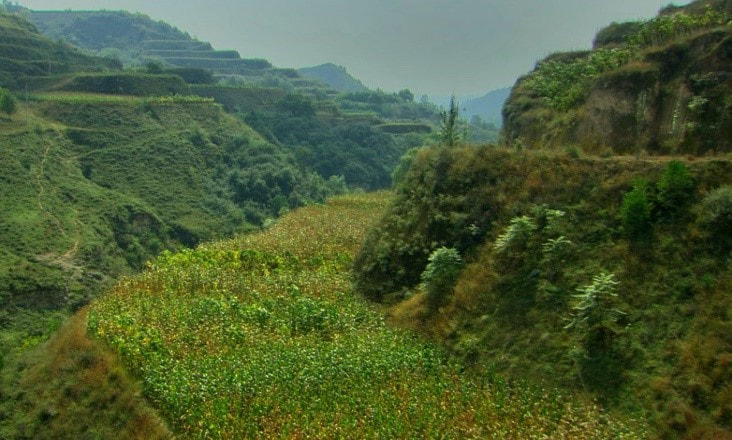|
By Bill Blackburn
(first in a series of Loess Hills articles. Stay tuned for future posts!) Take a drive along I-29 any fine day and you will see an extremely rare site—the Loess Hills. “Loess,’ which according to Webster can be pronounced as “luss,” “Lois,“ or “less,” is a German term meaning loose or crumbly. It refers to a yellowish deposit of wind-blown rock dust found in Germany, Argentina, New Zealand, U.S., China, and many other parts of the world. However, it forms hills of significant height (60-350 feet) only in two places: in the Yellow River region in and around Shaanxi province, China, and in the mini-mountains (bluffs) in the Midwest U.S. running parallel to the Missouri River 220 miles from Mound City, MO to Westfield, IA. In Iowa, the beautiful sharp-cliffed hills pass through the western sides of Fremont, Mills, Pottawattamie, Harrison, Monroe, Woodbury, and Plymouth Counties. Our 640,000-acre bluffs are geologically speaking relatively new, having been formed only 12,000 t0 115,000 years ago when glaciers were grinding rock into powder in the north, which was carried down the Missouri River, deposited on the bottom ground and eventually blown westerly into dunes. But the granddaddy of loess hills is the Chinese “Loess Plateau,” which covers an area only slightly less than the entire state of Texas located several hundred miles southwest of Beijing. In China, the loess eroded from various mountain areas over millions of years, was collected in the Gobi and other deserts and from there was blown into the plateau. But the wind is still at work there, causing the plateau to gradually move to the southeast over time. As in the U.S., the Chinese loess is highly erodible, so much so that the Yellow River which passes through the plateau was named because of the vast amounts of yellow-brown loess it carries downstream. The Loess Hills are rich aesthetically, ecologically, and historically. The U.S. Loess Hills Byway, which threads through the hills, was named one of the 10 most scenic roads in the country by nonprofit Scenic America. The state of Iowa has cited 39 rare animal and plant species in the hills. Hills animals such as the plains pocket mouse, ornate box turtle, Great Plains skink (lizard), and spadefoot toad are becoming rare and even endangered. Bald eagles and a wide range of other birds reside there or pass through annually. The bluffs contain three-fourths of Iowa’s remaining natural prairies. The Bluffs region is one of the country’s prehistoric gems, having been traversed by humans for over 12,000 years. It is home to more than 800 archeological sites, including late settlements of Mill Creek (900 AD), where predecessors of the Mandan tribe resided, and the Glenwood site (1000 AD or so), where 80 lodge sites of Pawnee and Arikaras ancestors were discovered. The region opened the gates for pioneers moving westward from there through the Mormon, California and Oregon Trails, and later, from the eastern terminus of the transcontinental railroad. The history of China’s Loess Plateau is even more impressive. It is the location of the 1.3 million-year-old site displaying the oldest use of fire by Homo erectus, the predecessor to modern humans. The fertility of the region around the Yellow River valley enabled it to become the cradle of Chinese civilization. It was an important trading center on the famous Silk Road. Its military importance was reflected by the famous terra cotta army of the Qin Dynasty Emperor that was buried there. The region served as the home to subsequent Chinese dynasties up to the 900s AD, when the capital was moved, eventually to Beijing. By the time the center of Chinese culture had move out of the Loess Plateau, the area had become massively eroded from overgrazing and deforestation, with the resulting erosion filling the Yellow River with deposits of so much loess that devastating flooding of croplands became common. A huge restoration project funded largely by the World Bank set out to partially restore the plateau over an area roughly the size of New Jersey. Whether in China or Western Iowa, the loess hills are a rare gem of past, present and future importance—aesthetically, ecologically, historically and economically. They deserve our appreciation.
0 Comments
Leave a Reply. |
Archives
June 2024
Categories
All
|
Address712 South Highway Street
P.O. Box 189 Oakland, IA 51560 |
ContactPhone: 712-482-3029
General inquiries: [email protected] Visit our Staff Page for email addresses and office hours. |


 RSS Feed
RSS Feed